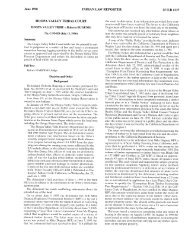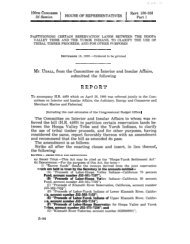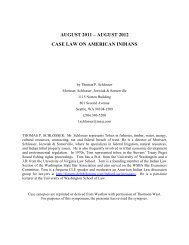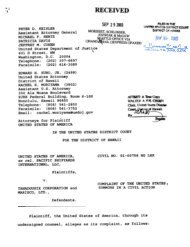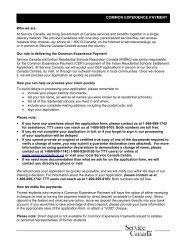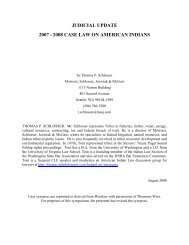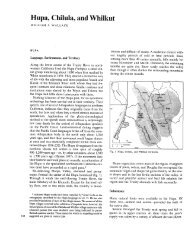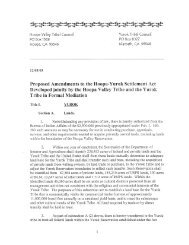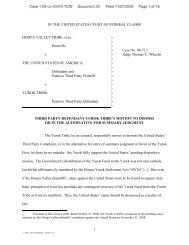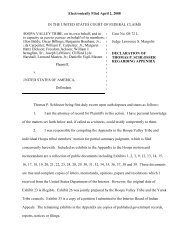Hoopa appendix supporting summary judgment - Schlosser Law Files
Hoopa appendix supporting summary judgment - Schlosser Law Files
Hoopa appendix supporting summary judgment - Schlosser Law Files
Create successful ePaper yourself
Turn your PDF publications into a flip-book with our unique Google optimized e-Paper software.
or have come to light since the enactment ofthe Act The report first provides the factual and<br />
le~lbackground leading to the Act, the structure and intent of the Act, the takin~claims<br />
flied by the Yurok Tribe, Karuk Tribe and Amnmon plaintif~,the disposition by. the courts,<br />
and finally our recommendations for legislative action. —<br />
Backgmufld<br />
The <strong>Hoopa</strong>-Yurok Settlement Act is best understood in. the context of a long and<br />
complex dispute, which, despite the best intentions of Congress, is not yet finally resolved.<br />
The Yurok people were aboriginal residents of the area that later became the joint <strong>Hoopa</strong><br />
Valley Reservation. In the early 1 850s, the federal government adopted a reservation policy<br />
as the principal means to reduce recurrent warfare between whites and Indians caused by the<br />
California gold rush. In 1855; -the~President-established theKiamath River Reservation, a<br />
strip of land a mile in. width on either side ofthe Kiamath River from the Pacific Ocean to a<br />
point about 20 miles upstream, as a permanent home for the Yurok people who then resided<br />
along that River. In 1864, Congress clarified the authority of the President to create<br />
reservations in California by authorizing four such reserves for Indians residing there. The<br />
1864 Act evinced Congress’ intent that reservations created under the Actwere to be occupied<br />
and owned by more than one tribe at the President’s discretion.<br />
In. 1876, the President exercised this authority by issuing a trust patent for the <strong>Hoopa</strong><br />
Valley Reservation, a 12-mile square bisected by the Trinity River (the “<strong>Hoopa</strong> Square”).<br />
The <strong>Hoopa</strong> Square was home to several groups of Indians, including the Yurok Tribe. In<br />
1891, the then <strong>Hoopa</strong> Valley Reservation was extended to encompass what had been known<br />
as the Kiamath River Reservation (the “Lower 20”), as well as the strip of land a mile in width<br />
on either side ofthe Kiamath River from the upper limit of the Kiamath River Reservation to<br />
the confluence of the Kiarnath and Trinity Rivers at Weitchpec (the “Connecting Strip”);<br />
together these lands became known as the “Extension.” These actions of the federal<br />
government established this area as a single, unified reservation. The U.S. Supreme Court in<br />
Matt7 v. Amett~referred to the entire joint reservation as “recognized,” explaining that the<br />
enlargement was made under the President’s authority pursuant to the 1864 Act. 412 U.S. 481<br />
(1973). Since time immemorial, the Yuroks and other Indians of the joint reservation have<br />
centered their lives and cultures on the land within the reservation’s boundaries.<br />
In the decades following the consolidation of the <strong>Hoopa</strong> Valley and Kiamath River<br />
Reservations, the policies ofthe Bureau of Indian Affairs concerning the beneficiaries ofthe<br />
<strong>Hoopa</strong> Valley Reservation varied; for some purposes, and at some times, the B.LA. treated<br />
the Reservation and the Indians thereof as a consolidated whole; at other times, and for other<br />
purposes, the B.LA. regarded the <strong>Hoopa</strong> Square as separate and distinct from the Extension,<br />
and only the individuals enrolled in the <strong>Hoopa</strong> Valley Tribe were recognized as possessing<br />
rights in the <strong>Hoopa</strong> Square.<br />
2



